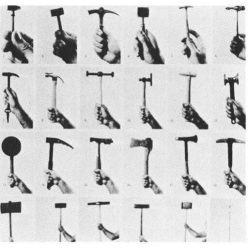This post documents my tutor, Kwame Baah’s observation of one of my asynchronous resources. Copied below is the form that documents the observation and subsequent reflection.
Session/artefact to be observed/reviewed: CTS1 seminar with User Experience Design yr1 students
Size of student group: 35 students
Observer: Kwame Baah
Observee: Rujana Rebernjak
Part One
What is the context of this session/artefact within the curriculum?
CTS1 is the first year unit in Contextual and Theoretical Studies that runs for 11 weeks in block 2. This is the last session of the term. Each session explores key conceptual themes relating to design – this one is focused on Identity. The session will involve a 2hr seminar on the theme followed by a 1hr workshop for students to develop ideas for their final assignment (1600-word essay).
How long have you been working with this group and in what capacity?
Since the start of the academic year.
What are the intended or expected learning outcomes?
The following are the aims and outcomes of the session:
- Students understand the key reading on the theme of Identity set by tutors
- Students are able to identify key theoretical ideas relating to the theme of identity and know how to research it further
- Students are able to relate the theme to their own knowledge and practice as UX designers
- Students start developing independent enquiry around this topic in preparation for their final assignment
What are the anticipated outputs (anything students will make/do)?
- Students will engage in group discussion, producing short pieces of writing and building their confidence to share and discuss their ideas as part of a group
Are there potential difficulties or specific areas of concern?
- Students from this group vary in terms of their language skills and confidence to present their ideas publicly. Many struggle to understand complex texts so the task of the session is to break down the reading as a group so that they are able to digest some ideas as preparation for further independent study around this topic.
How will students be informed of the observation/review?
- Students have been informed verbally and in writing via weekly email sent the Friday before the session
What would you particularly like feedback on?
- How to engage students whose language skills seem to preclude them from participating and engaging with the session more thoroughly.
How will feedback be exchanged?
- TBC
Part Two
Observer to note down observations, suggestions and questions:
Your teaching methodology is rich in supporting components that enable students to critically analyse their own perspectives on objects. By fostering continuous collaboration among students, you are able to strengthen their learning experience. One effective strategy you implemented was the seating arrangement, which promoted cross-collaboration as each pair of students provided mutual support during activities.
I was particularly impressed by your efforts to ensure that all students comprehended the instructions at each stage, showcasing your awareness of the diverse language skills among the student body. Your practice of revisiting the activity requirements at each table when they to communicated in their native language within groups, facilitating peer support.
My only query pertains to the potential benefits of rearranging student groups to enhance cohesion, as I observed most students tended to sit within their existing friendship circles. Furthermore, there were a few students who appeared isolated within groups that lacked meaningful communication beyond the task at hand.
Part Three
Observee to reflect on the observer’s comments and describe how they will act on the feedback exchanged:
Thank you for your encouraging and positive feedback. Since the start of the unit, we have been experimenting with different formats for our seminars to find the right way of fostering and facilitating student discussions. Small group work with feeding back to the overall group seems to be a good strategy, allowing students to digest the questions/tasks, working together and supporting each other, whilst also building confidence to share their thoughts in a larger group setting. When doing these sessions the book ‘Shy Radicals’ by Hamja Ahsan is always on my mind, and I find myself questioning why certain established models of teaching – i.e. seminar discussions – are valued in higher education and how we might disrupt these models to foster different ways of learning that are more culturally inclusive.
As you recognize, there are particular groups in this cohort who seems to struggle with this mode of teaching, retreating into their groups and engaging in other activities during the seminar (online shopping, browsing, watching other videos, doing other course work). In these situations, this makes me wonder whether students don’t find that class interesting? Do they find the content irrelevant to their learning or practice? Or are there other barriers to their participation – are they shy radicals? Therefore, going forward I will consider other ways of engaging these students, perhaps it might be by working with them 1-2-1, taking them outside of that group-work setting, or maybe just by rearranging groups as you suggest.
In the second half of the session that you observed, this was the case. We re-distributed students in groups, making them interact with peers they might not normally interact with. However, this brought mixed success as some students even further retreated into their own space when faced with the prospect of having to work with unfamiliar colleagues. Therefore, perhaps breaking up the space and table setting even further to facilitate smaller groupings (2-3 students max) would be useful as the challenge is most evident when there are 7-8 students sitting at a large table and nobody seems to want to take ownership over their learning in such a large group (it is easier to retreat). Of course, the usual constraints of space limit my pedagogic approach – but I can invest some time in making that space more suitable for the type of delivery we envision would be most effective.

